Phillies 2021 Spring Training Preview: Pitching Staff

Unlike the lineup, the Phillies pitching staff will have a lot of questions coming up this season, especially in the bullpen. In 2020 the starting staff and bullpen were completely different, the Phillies ranked 10th in Starter ERA in 2020 with a 4.08 in 311.0 innings pitched. The bullpen meanwhile was last in baseball with an ERA over 7.
With this situation, Dave Dombrowski made sure the Phillies made upgrades to improve the pitching in 2021. Today we will look at the entire staff heading into 2021.
Phillies ace Aaron Nola
Starting things off with likely opening day starter Aaron Nola, Nola really impressed in 2020 with the second-best season in his career. After a not as good 2019 where he had just a 115 ERA+, 4.03 FIP, and a 3.82 xFIP there were some questions about if Nola could be the ace of the Phillies pitching staff.
In 2020 he answered the question with a 139 ERA+, 3.19 FIP, and a 2.79 xFIP. One of the things that stood out to me for his jump in 2020 from 2019 was that he walked less and struck out more. In 2019 Nola struck out 10.19 batters per 9 innings ranking him in the 72nd percentile, in 2020 that jumped to 12.11 strikeouts per 9 ranking him in the 91st percentile.
With walking fewer guys Nola did a great job of that also. In 2019 Nola was walking 3.56 batters per 9 innings ranking him in just the 30th percentile, in 2020 he lowered his walk rate to 2.90 batters per 9 and ranked in the 57th percentile.
It is a lot easier to be a good pitcher when you strike out more batters and walk less, and that was a big reason for Nola taking a step forward in 2020.
Overall at 27 years old, there is no reason to think Nola can’t get any better and become more like the pitcher we all think he can be, an ace.
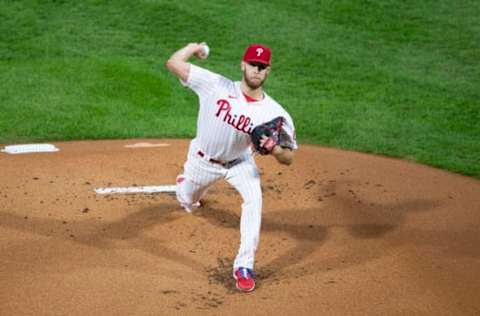
Zack Wheeler
Up next in the order is the only pitcher that could compete for the opening day spot with Nola, Zack Wheeler. Wheeler had the best season of his career, the first year away from the Mets. Back in December of 2019, Wheeler agreed to a 5-year contract worth more than $100 million to be the Phillies number 2.
There is no argument that what Wheeler did in 2020 proves he can be worth the deal, 156 ERA+, 3.22 FIP, and a 3.76 xFIP. All career highs for the new pitcher in pinstripes.
What did Wheeler do to have a career year? One large reason is he got a lot more ground balls in 2020 but also had the lowest strikeout rate of his career.
Wheeler got groundballs against 55.9% of the batters he faced, a career-high. However, he struck out fewer batters per 9 at just 6.72, both of these numbers don’t seem sustainable for his career but this could also mean with pitching coach Bryan Price that this would be the weirdest but the best way for Wheeler to maximize his pitching.
Another thing that stuck out to me was Wheeler used more of his fastball in 2020. In 2019 he was throwing his fastball 59% of the time. In 2020, that went up to 66% of the time so clearly, this was something the Phillies pitching staff wanted him to do. This is a very sustainable thing since coaches were probably telling him to do this.
Now, who knows what Caleb Cotham will carry over from what Price did but I would imagine we will still see Wheeler throwing fastballs more than 65% of the time in 2021.
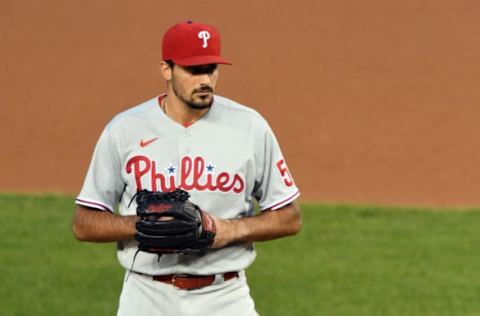
Zach Eflin
No. 3 starter Zach Eflin is next on the list for pitchers. Eflin put together a career year in 2020 with a 115 ERA+, a 3.39 FIP, and a 3.23 xFIP.
In 2020 there were some interesting things Eflin changed from 2019 that allowed him to be a better pitcher. For starters he didn’t throw a pitch more than 34% of the time, using his fastball the most at just 33.6% of the time. In 2020 that changed drastically with Eflin throwing the sinker more than 51% of the time.
Another fun fact is that he threw the fastball a lot less in 2020 at just under 10% of the time. So clearly there was a completely new plan for Eflin under pitching coach Bryan Price, they want him to use a lot more of the sinker to keep the ball down, making Eflin much more of a ground ball pitcher.
The good news about Eflin’s 2020 season is what was mentioned earlier, Eflin’s FIP and xFIP suggest he was getting unlucky with his pure ERA production as both were lower than his ERA. If there is one sign that Eflin might’ve found something, that is the one.
The biggest question now is to see what another new pitching coach will do for Eflin, will Caleb Cotham continue to groom him into the pitcher he was in 2020 or try to make him the pitcher he was in 2019?
Chase Anderson
Free-agent signing Chase Anderson spent last season with the Blue Jays and he did not have a very good 2020.
Anderson in 2020 had an ERA+ of 61, 6.16 FIP, and a 4.09 xFIP with the Blue Jays last season.
On the surface, this seems like a very strange signing by Dombrowski, but when you look further, it could be a good get for the Phillies.
In 2018 and 2019 Anderson averaged a 105 ERA+, and a 5.04 FIP, not amazing but a lot better than his 2020 season. Not to mention he had a fantastic outlier year in 2018 with a 160 ERA+.
The weirdest thing about his bad 2020 season is there are good signs from it, he had a career year for strikeouts per 9 at over 10, and one of his best walks per 9 seasons at just 2.67.
The thing that killed Anderson was the opponent’s insane BABIP at .362, and his homerun flyball ratio being way too high at 28.9%.
It is easy to assume that these numbers should go down for Anderson in 2021 and if the strikeout and walk numbers keep getting better, Anderson could be a steal for the Phillies in 2021.
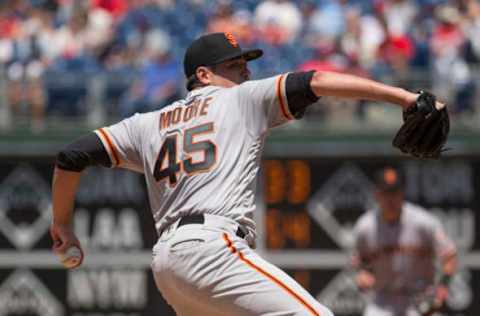
Matt Moore
A weird signing by the Phillies comes up next in Matt Moore on a 1-year deal. Moore was a former Tampa Bay Rays prospect who put together some good seasons early in his career but fell off and went to the NPB this last season.
Moore began his first 2 full seasons with promising years, 3.81 ERA, 3.93 FIP, and a 4.35 xFIP his first full season in 2012, and 2013 he was even better with a 3.29 ERA, 3.95 FIP, and a 4.32 xFIP.
In 2014 and 2015 he didn’t throw a lot of innings due to a sprained UCL, this would start his downfall since he hasn’t been the same pitcher at all.
The next step in Matt Moore’s journey was the NPB, going to the SoftBank Hawks in 2020 to get his career back on track.
That season Moore went 6-3 in 13 games, 78 innings pitched and had a 2.65 ERA and that was enough promise for him to sign in Philadelphia.
Explaining what the expectations should be for Moore seems pretty impossible, the NBP is a good league but how will his numbers translate to the MLB? What did he change in his pitching? We won’t know until the beginning of the season to see where things stand on Moore.
Spencer Howard
The No. 1-ranked Phillies prospect on MLB.com, Spencer Howard spent 2020 mostly in the Majors and made 6 starts in the shortened season to not amazing results.
78 ERA+, 5.86 FIP, and a 5.03 xFIP is garbage and there’s no other way to say it nonetheless, there are somethings we can point out that maybe gave Howard a disadvantage.
In a weird 2020 season, you can argue this is very hard for prospects who are just getting called up, let’s face it this past season was weird and it might be harder for someone just getting into the Majors.
Before this season, Howard was making his case to be the Phillies best prospect, in Double-A in 2019, Howard showed great signs with a 2.35 ERA, 2.62 FIP, and a 2.66 FIP in 30.2 innings. It is not like Howard can’t pitch, another possibility for why he struggled could be from making the jump from Double-A to the Majors.
Sometimes you may need time in Triple-A before making the jump to Major League Baseball and that is ok.
The only reason we could be concerned is if Howard is not pitching well in Triple-A, that could be a sign he isn’t developing at the pace they need him to, and if that’s the case, Phillies fans should panic.
Overall, expect Howard in Triple-A to begin the season and if he pitches well, he could be called up as the 5th starter, especially if Chase Anderson and/or Matt Moore are not performing.
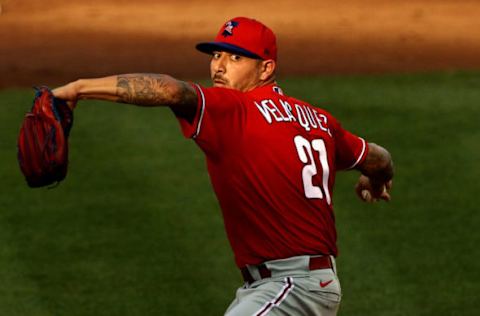
Vince Velasquez
Now we go into the sad case of Vince Velasquez, who just has never hit his ceiling in Philadelphia. The Phillies acquired Velasquez in a trade involving Ken Giles going to Houston.
Velasquez is the last standing piece of that trade and many fans would like to see him in a new uniform, but since he’s still here, we need to figure out what value he can provide to the Phillies in 2021.
The question has never been about stuff and potential, the question is if he can produce and so far he hasn’t. This past season he had the worst ERA of his career at 5.56.
Now that seems bad but there are a few things that can make this sound a little bit inflated with poor luck. He has a FIP of 4.16 and an xFIP of 4.07, along with this his BABIP was really high at .373, so he was pretty unlucky.
With the signings of Anderson and Moore, it is very much possible the Phillies are fully committing him to a reliever role, which could do him well. In 2020 he ranked in the 81st percentile for Fastball Spin and he averaged 12.18 strikeouts per 9.
Maybe a new role is good for him and will give him some hope, they are paying him $4 million this season so it’s worth seeing if he is worth anything. Let’s see what happens in 2021.
David Hale
David Hale, who was among the 2020 midseason pickups, spent 2019 and part of 2020 with the New York Yankees. After former General Manager Matt Klentak needed to try and save his job, he was desperately traded to the Phillies.
Hale has not had much of an extensive Major League career so far and even spent time in the KBO in 2018. The most amount of innings he’s pitched in a single season is 87 1/3 in 2014 with the Atlanta Braves.
Combining 2019 and 2020 you might actually get some ok numbers, in 54.2 innings he has an ERA+ at 138 and a FIP of 3.46. That is not bad at all for Hale or really any pitcher but the rest of his career doesn’t have promising results.
Overall for his career, he has a 4.23 ERA and a 4.26 FIP in a larger sample size.
The question now is what kind of role will Hale have on the Phillies, well he will probably be on the Major League roster as a long reliever. If a Phillies starter doesn’t last long, Hale will come in and eat some innings so the rest of the bullpen isn’t gassed for the next game.

JoJo Romero
JoJo Romero comes into the 2021 season with expectations around him. You may wonder why someone who had an ERA at 7.59 would have some expectations on them for the next season.
With Romero, his ERA would really skew people’s opinion on him as there are other numbers to tell you he’s was not as bad of a pitcher as you may think.
With a 3.66 FIP and a 3.53 xFIP, it is a little safe to say that Romer’s ERA was very inflated, not to mention his BABIP was .375 so he was getting very unlucky as a pitcher during his 10.2 innings as a pitcher in 2020.
Another very encouraging part of Romero’s 2020 was his strikeout and walk per 9s. He averaged 8.44 strikeouts per 9 innings and 1.69 walks.
These are both really good and really show you why he can be a really solid pitcher in the Phillies bullpen in 2021. He may not have the super high expectations like for other guys next, but there are expectations Romero puts together a really solid 2021.
Connor Brogdon
Another promising young reliever Connor Brogdon is next. The expectations are even higher on Brogdon because his traditional and advanced stats look very promising.
For how bad the Phillies bullpen was in 2020 there were guys who we could see being dependable in 2021, and one of them is Brogdon.
Brogdon in 2020 had a 3.97 ERA, a FIP at 4.96, and an xFIP at 3.22. Not to mention he put up a great xERA at 2.42.
There is one thing that is extremely promising for Brogdon and that’s his strikeouts per 9 at 13.50. The best part is that is his way of pitching he is looking to strike you out and has never dropped below 10 strikeouts per 9 in his Minor League career.
The one concerning thing about all of this is his .105 BABIP which could prove Brogdon was a lucky pitcher in 2020. While he has never had an insane BABIP, it was never this good in years past so maybe we need to expect a few more hits given up in 2021.
Even with this being the case it is not like he will carry a significant role as a late-game situation pitcher for them in 2021. Similar to Romero he will be pitching more in the middle innings but with Brogdon there is potential he gets some late-inning work.
If worst comes to worst with the Phillies bullpen in 2021, we could see some Brogdon late innings for this team to close out games, and that may not be a bad thing at all.
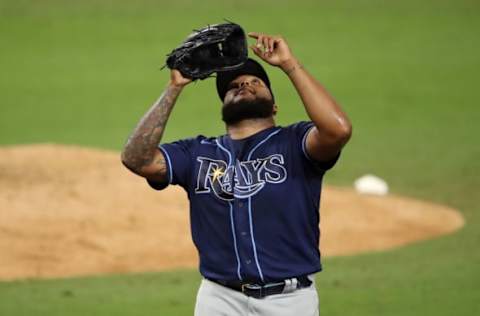
Jose Alvarado
The 25-year-old reliever is next to talk about. To say Jose Alvarado has the most potential out of any reliever on the Phillies might be an understatement given his age and some of the success he had with the Rays not too long ago.
In 2018 Alvarado in his only full season was really solid with a 2.39 ERA (172 ERA+), 2.27 FIP, and a 3.15 xFIP. In that 2018 season, he also ranked in the 92nd percentile in Fastball Velocity at 97 mph.
However, the problems are with what has happened since 2018 Alvarado has dealt with some different elbow problems limiting how much he can pitch. This is also probably a reason for why he was traded to the Phillies.
What the Phillies will hope is for Alvarado to regain form from his 2018 season which you can make the argument would make him the best reliever on the team.
The big question will be his health but if he’s healthy, nothing can stop him (except for his command).
Archie Bradley
Likely the most dependable reliever for the 2021 season, Archie Bradley is now the next pitcher to talk about. From the #SignJT movement he brought the second he signed, to his ability as a solid back-end option that the Phillies need out of the pen, this made this a great fit.
Bradley has consistently gotten better as a full-time reliever the past few seasons. In 2018 he has a 3.64 ERA, 3.71 FIP, and a 3.57 xFIP. In 2019 that improved to a 3.52 ERA, 3.41 FIP, but had a dip in xFIP at 4.06. In 2020 he puts it all together with a 2.95 ERA, 2.59 FIP, and a 3.67 xFIP.
While this is a great improvement over the 2020 bullpen, 2020 will no longer be the standard especially for Bradley and there is potential fear we might be hyping him up a little bit too much.
His career FIP is just 3.98 which doesn’t suggest a lock-down closer for the bullpen. In 2020 he also dropped in velocity on his pitches. Fastball went from 96 to 94, Curve from 82 to 80, and his changeup from 88 to 86.
This could be a change he made on his own and we will find out this upcoming season but this is not the news you want to be hearing from only a 28-year-old reliever.
Bradley is still a great upgrade and should be the best arm in the bullpen if you had to bet on it, with that said there could be cause for concern if this continues.
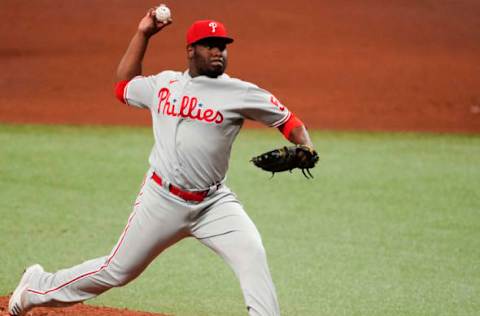
Hector Neris
Long time closer Hector Neris is next. While he has been the guy in the 9th for a while now, that may change in 2021. Neris will not be the favorite to win that job in Spring Training with Archie Bradley and Jose Alvarado joining the Phillies this off-season.
A big part as to why he isn’t the favorite is the inconsistency he has presented year to year. In 2017 Neris was solid with a 3.01 ERA, 3.71 FIP, and a 4.21 xFIP.
2018 was rough and at one point was sent down to Triple-A. 5.10 ERA, 4.04 FIP, and a surprising 2.71 xFIP.
He would regain form in 2019 his best season since 2016, with a 2.93 ERA, 3.83 FIP, and a 3.53 xFIP.
Now we get into his 2020 season where there are 2 things we need to note before listing his stats, one is that he had a lot of pressure on him with the weak depth they had in the bullpen. Another thing is that his FIP is a lot lower than his ERA and xFIP with a 4.57 ERA, 2.50 FIP, and a 4.10 xFIP.
The consistency has just not been there for Neris in his career and the Phillies are not trying to bank on Neris having a bounce-back season. If he does, that is excellent news to the back end of the bullpen, but if he doesn’t it won’t be the worst thing in the world.
Sam Coonrod
Another pitcher the Phillies acquired this offseason is Giants righty Sam Coonrod.
The good thing about Coonrod is his potential as an off-speed spin-rate and hard-throwing reliever out of the bullpen. The bad thing is that he hasn’t ever proven himself.
In 2020 he had a 9.82 ERA, 4.76 FIP, and a 5.22 xFIP which by any means is pretty bad. The one positive is that he did strikeout over 9 batters per 9 innings but still, the overall production is not very good at all.
He did have a solid 2019 with his ERA at 3.58 however, he had a significantly higher FIP and xFIP at 5.24 and 5.70.
He has potential but it will be hard to imagine him seeing it this season with their bullpen depth. It is likely that he starts in Triple-A and works his way to the Major’s later in the season.
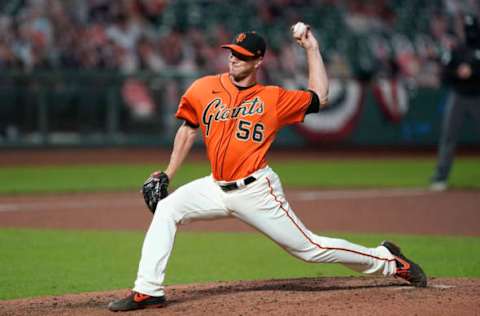
Tony Watson
Veteran left-hander Tony Watson joins the list of Phillies pitchers to talk about as he recently signed as a non-roster Invitee. Along with over his 9 years of big-league service time, Watson could bring dependability to the bullpen, but if he makes the roster.
While it may be pretty likely he makes it, it is not a shoo-in like last year would’ve been. Watson will have to compete without a guaranteed 40 man roster spot.
The good news with Watson is that he’s a very solid pitcher for his career including 2020 with an ERA at 2.50, FIP at 4.36, and an xFIP at 4.12.
While 2019 wasn’t great, 2018 was a very good season for him at 2.59 ER, 2.45 FIP, and a 3.09 xFIP. If the Phillies get numbers close to this, Dombrowski is getting a steal at $3 million.
If that’s not the case, then hopefully he just doesn’t make the team in camp or you can just DFA him, not a big deal.
Brandon Kintzler
We wrap this preview up with Brandon Kintzler who signed a NRI deal with the Phillies about 2 weeks ago.
Kintzler gets talked a lot about his 2020 and when you look specifically at his ERA, you can say he deserves that praise however, his 2019 was actually better and more of what the Phillies should be looking for.
In 2020 Kintzler did have a 2.22 ERA but had a FIP of 5.00, and an xFIP of 4.98 so it is really hard to imagine him keeping up with that sort of luck.
In 2019 Kintzler had a higher ERA at 2.68 but had lower FIPs and xFIPs at 3.56, and 4.06. He struck out more batters per 9 at 7.58 compared to 5.18 in 2020. He walked fewer batters too in 2019 at 2.05 per 9 compared to 4.07 in 2020. He even allowed fewer home runs per 9 in 2019 allowing 0.79 compared to 1.11 in 2020.
If the Phillies get a more 2019 version of Kintzler then the Phillies should be really happy with that signing, 2020 seems a lot harder to repeat successfully.
Overall Dave Dombrowski, Sam Fuld, and the rest of the Front Office may have had some questions to ask with the starting rotation signings, we have to give them praise for the bullpen. The Phillies should be much better later in games because of the moves he has made.
The bullpen will have a much higher floor and ceiling in 2021.
More. Phillies 2021 Spring Training Preview: Position Players. light